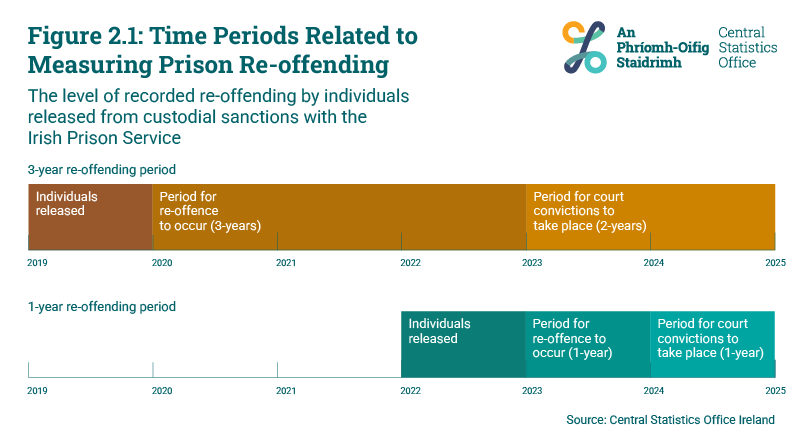This release is categorised as a CSO Frontier Series Output. Particular care must be taken when interpreting the statistics in this release as it may use new methods which are under development and/or data sources which may be incomplete, for example new administrative data sources.
Re-offending statistics provide government policy makers, criminologists, and other stakeholders with indicators of the numbers of individuals that re-offend and the rate of re-offending across different types of crime. Monitoring re-offending rates provides insight into the:
Re-offending statistics for the prison release and probation supervision population of Ireland are published annually by the Central Statistics Office (CSO). The re-offending rate for these releases is determined by monitoring the crime related activity of offenders after they have been discharged from a justice sanction such as custody or probation supervision. People that are discharged and who then get convicted for a further offence are counted as re-offenders. The population’s re-offending rate is then calculated by measuring the proportion of offenders that re-offended within a period following their release as a proportion of the overall prison and probation release population. Typically, one to three year periods are used as the qualifying period to calculate these statistics as most re-offending takes place within this timespan. The CSO’s published estimates for probation and prison re-offending calculate re-offending in this way, with the most recently available data covering individuals discharged from their justice sanctions in 2020 and 2022.
Figure 2.1 below shows the time periods and process of establishing these re-offending indicators for the prison re-offending of individuals released in 2019 (three-year re-offending) and 2022 (one-year re-offending). The three-year re-offending period refers to individuals released in 2019. The time period for a re-offence to occur is three-years (2019 to 2022) and a further two-years are left for court decisions (convictions/acquittals) to take place. The one-year re-offending period relates to individuals released in 2022. The time period for a re-offence to occur is one-year (2023) and a further year is left for court decisions (convictions/acquittals) to take place. (See Figure 2.1).

There are three main drawbacks to existing methods of calculating re-offending rates.
1. Timeliness:
A lengthy period must elapse (three to five years) following release or discharge from a justice sanction before a re-offending rate can be established (see Figure 2.1). While this period is necessary to determine if a re-offence has occurred it results in a significant lag in the production of estimates.
2. Coverage:
The current CSO's Prison and Probation Re-offending releases exclude individuals detected to an offending crime incident that were not part of the annual prison release or probation supervision population. This means those individuals who may have received the following sanctions for their offending are not included in the re-offending estimates:
3. Comparability:
This release provides estimates of re-offending using an alternative method that is designed to provide re-offending rates for more recent reference years (up to and including 2024). The detected incident re-offending rate for this release is determined by calculating the proportion of crime incidents during 2024 that have been detected (linked) to a suspected offender who has previously been detected to at least one previous crime incident.
When an incident is linked to a suspected offender who has also been detected to another PULSE incident more than 24 hours earlier, the incident is classified as a single re-offending incident. However, if the incident is linked to a suspect with no previous detections, then the incident is not classified as a re-offending crime incident for the purposes of the estimates.
This method of using a person’s detection to a crime incident as the re-offending indicator both:
The tables in this release that provide statistics on the incident characteristics of the re-offending indicators are using a category aggregation of crime incidents rather than the existing offence categories of the Irish Crime Classification (ICCS). Using incident descriptions as opposed to offences can help to provide a greater level of accuracy and detail about the characteristics of the incident that re-offenders are linked with rather than the characteristics of the resulting offences which can often involve more than one type of offence.
Further details of the methodology for estimating crime incident re-offending are in the Background Notes of this release.
Learn about our data and confidentiality safeguards, and the steps we take to produce statistics that can be trusted by all.